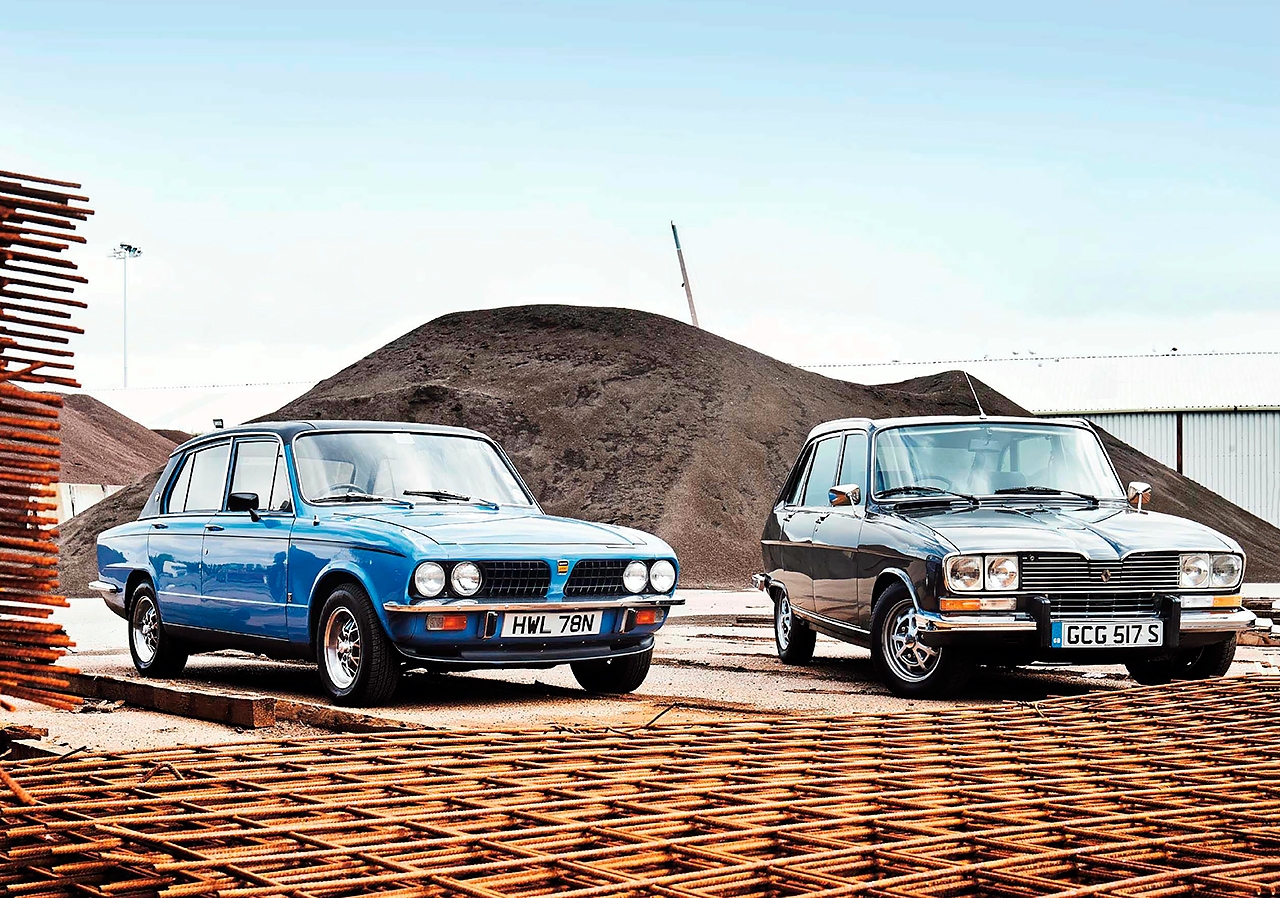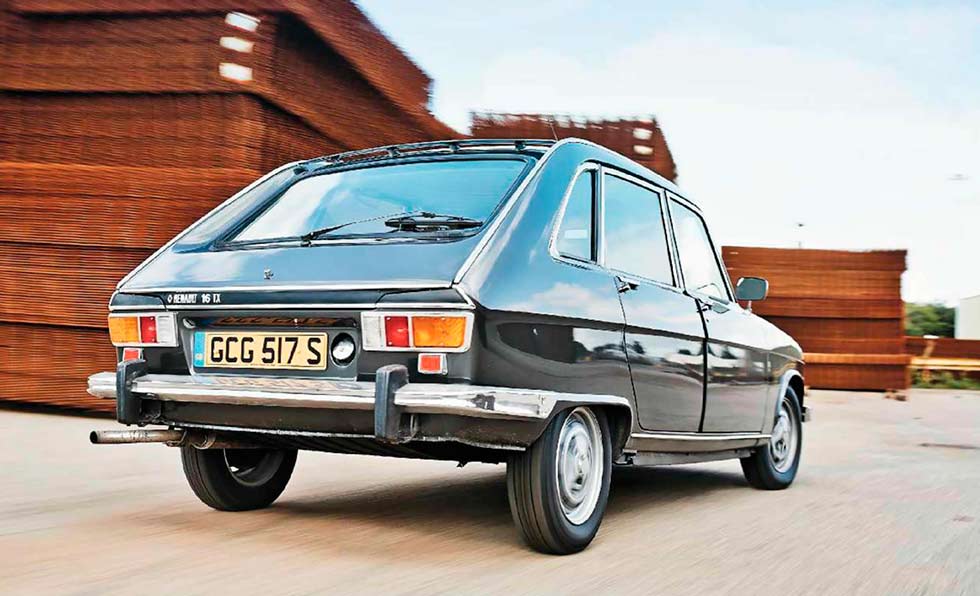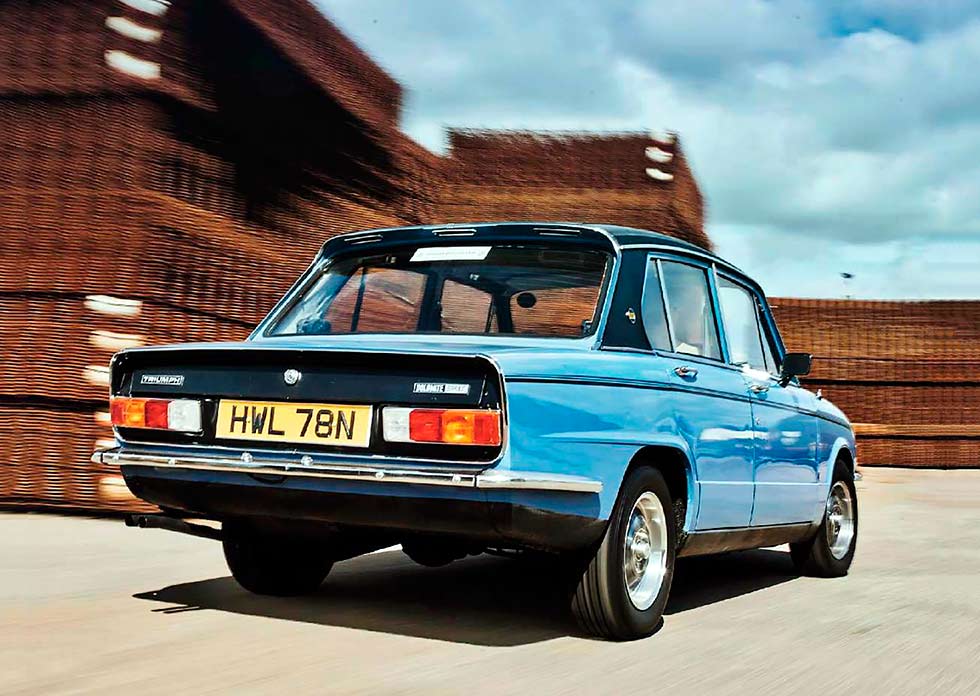
Express Triumph Dolomite Sprint vs. Renault 16TX. Can two sports saloons that got pulses racing in the Seventies still enthral today? We drive them head to head to find out. The Triumph Dolomite Sprint and Renault 16TX offered sporting fun to Seventies execs. We find out which did it better. Words Andrew Roberts. Photography Gus Gregory.
If you ask a classic enthusiast to describe typical early Seventies medium-sized executive transport they might evoke images of coke-bottle styling, black vinyl roofs and sports wheels. There might also be references to vulgar paint finishes to match a taste for Jason King-style tailoring, three gallons of Hai Karate aftershave and Luncheon Voucher-funded dinners at the Woking branch of Berni Inns. But our two test cars, parked in the mean docklands of East Anglia, were more interested in appealing to motorists who craved technical innovation, creature comforts and genuine performance.
The Renault 16TX and the Triumph Dolomite Sprint were both launched in late 1973 and of the pair it is the BL offering that initially seems closer to the ideal of a sports saloon of four decades ago. But the Sprint’s alloy wheels (a first as standard equipment on a British car), front spoiler and matt black trimmings cannot quite mask styling that dates back to the Sixties, as demonstrated by its thick screen pillars and quarterlights in the front doors. This is not to say that the Dolomite looks vulgar, as its Michelotti-designed coachwork matures well and the Sprint detailing emphasises rather than masks its charms.
No French Blue Dolomite Sprint could ever look as chintzy as a Ford Cortina GXL MkIII and nor could the sale reps’ favourite hope to match the Triumph’s abilities. The Dolomite Sprint is an absolute gem, a go-kart with the luxury of a far more expensive machine and a vehicle that’s just as at home in the directors’ car park as it is shooting down the M1. It feels heavy though not overly so at very low speeds, but once you’re above 15mph the steering is light and positive and the gearbox cries out to be used, the ratios cleverly chosen to derive the best from the flexible engine.

1977 Renault 16TX road test
The Sprint never sounds harsh but feels most content to purr along at 70mph – but overdrive changes the ratio up, for lower rpm and more relaxed cruising. For overtaking, go for a rapid changedown with the gearlever, then possibly flick overdrive for an intermediate ratio as your speed builds.
Speeding the Sprint around the shipping containers as though B-film baddies were on my tail provides no difficulty as the Triumph holds the road with entertaining assurance, any momentary understeer dispelled by lifting the throttle. It also stops well and although some contemporary road testers complained that the ride was not the smoothest this wasn’t my experience. Dockside roads are rarely renowned for their well-maintained tarmac but the Dolomite is a highly comfortable way to travel.
One mild surprise is how diminutive the Triumph seems in modern-day traffic as my youthful impressions of the Dolomite, reinforced by the first season of The Professionals, were of quite a substantial car. But aside from an elongated boot, the Sprint has much the same dimensions as the 1300 and, as with its predecessor, the Dolomite aims to provide comfort for a quartet rather than plausible transport for five. The Triumph’s cabin is a tasteful blend of wood veneer and thick nylon, tradition and modernity co-existing in reasonable harmony. The driver’s seat is adjustable for reach and tilt, and there’s a telescopic steering column.

Roof spoiler hints at sporty intentions.
Meanwhile, the dashboard conveys the impression that I’m in the cockpit of a 747 as I face the ‘All Systems Go’ warning lamp roundel. By my left knee there is also a cigar lighter, reassuring the Dolomite driver that he was definitely in the Panatella class. The Triumph’s tall cabin, a legacy of being designed at a time when chaps still regularly wore hats, results in excellent headroom.
The Dolomite Sprint marks the zenith of one of the most complicated car ranges in British motoring history, one that within just eight years embraced front-and rear-wheel drive, two or four doors, different boot lengths and variations in rear suspension. The original front-wheel-drive Triumph 1300 made its debut in 1965. That was superseded in 1970 by the 1500, which had a longer boot and a new front grille with four headlamps. The same year also saw the launch of the Toledo, a rear-wheel-drive Herald replacement with the 1300’s body, in both two- or four-door form, and a live rear axle in place of the 1300’s independent layout with semi-trailing arms.

Column shift and front-wheel drive allows roomy interior. Neat packaging makes excellent use of tight engine bay.
As for the Dolomite Sprint, this debuted in 1972 as a slightly overdue successor to the Vitesse and combined the 1500’s body with rear suspension similar to the Toledo and a hotter variant of the slant-four engine originally developed by Triumph for the Saab 99 driving the back wheels. The Sprint version was devised, in the words of Bill Davis, the managing director of Rover/Triumph, to ‘dispel the myth that the Continental manufacturers have a virtual monopoly of fast, medium-sized cars’. British Leyland lacked the resources to develop a new twin-overhead-camshaft unit so Spen King, working with Coventry Climax, increased the cylinder bore to expand the Dolomite’s 1854cc unit to 1998cc, and replaced the Stromberg carburettors with twin SU units.
Meanwhile, Triumph engineer Len Dawtrey devised a method of having 16 valves operate from a single camshaft and the result was claimed to be the world’s first mass-produced multi-valve car, a small saloon with vivid acceleration that could offer more comfort than a Ford Escort RS2000 owner could dream of. The Sprint came at a price that undercut a BMW 2002tii by more than £1000, and the fact that it was British-built and came with four doors gave the latest Dolomite an appeal to the average company car buyer that its West German rival clearly lacked.
However, if you sought – or your firm’s accountant allowed – a more offbeat choice of well-appointed medium-sized saloon from overseas for virtually the same price as the Sprint, there was always Renault’s new 16TX. This was a car so removed from the norm that you could boast to your neighbours that not only did you drive a foreign car with five doors, it was one with an asymmetrical wheelbase too. The first Renault 16 debuted in the same year as the Triumph 1300 and retained the same body for the next 15 years, yet our test car seemed less dated than its British competitor; the fivedoor body a testament to function dictating form.

Renault isn’t quite as fun, but it’s a much more refined drive. The Dolomite is full of exploitable, immediate merriment.
This is not to infer a boringly logical approach to design for, as I lower myself into the armchair-like driver’s seat – one of the most comfortable of any car – I’m faced with a dashboard that pays no attention to any form of ergonomics. All 16s look as though various switches had been randomly hurled at the facia by blindfolded workers and this flagship model is no exception. The heater is controlled by an obscure knob hiding on the scuttle and elsewhere various mysterious switches lurk in odd corners. The TX’s sporting image is emphasised by chrome-rimmed dials set in a silver-faced instrument panel – elegant if not terribly readable.
The Renault’s facia may be as well-stocked as the Triumph’s but overall the 16 has none of the Dolomite’s sense of being a four-door sports car; the pedals are offset to the centre and the umbrella handbrake, hidden beneath the dashboard, is a masterpiece of inaccessibility. A column gearchange makes the 16’s Sixties origins very obvious, as does the vast steering wheel, although the TX does give you sports spokes. These help to distract from the extremely heavy steering, even by the standards of 40 years ago, and at low speeds the 16 does feel ponderous. There is also a self-centring action that can be quite disconcerting at first and when I attempt to accelerate out of a bend the wheel tugs back aggressively.

Standard alloy wheels were a first on a UK car. Steering wheel is perfectly sized for B-road twirling. 16v engine delivers a meaty 127bhp.
Still, after a short while the 16’s many virtues grow on me. The combination of a column shift with a flat floor makes space for two large front seat occupants and although the Dolomite is the faster of the two cars by a considerable margin the Renault is the more adept cruiser. This has less to do with respective levels of engine refinement – the Triumph doesn’t sound harsh and the 16’s powerplant feels close to the bulkhead – and more with the TX’s suspension system. This was a car designed to cope with the awful road surfaces of rural France and so despite the less-than-smooth tarmac the TX seemed to float above all minor irregularities. On straight roads it feels as effortless as a well-bred 3.0-litre, a mobile lounge that’ll speed along boulevards. It attacks corners with a rolling gait that’s more dramatic to witness than to experience. The gearchange accentuates its charms as potential autoroute transport. In 1973 a column shift was unusual on a medium-sized car in the TX’s class, let alone one with five speeds, but it works well in practice.
Unless the clutch is completely pressed down, first gear can baulk a little and the ratios feel slightly unorthodox, with a large gap between third and fourth gears. But the actual shifts are precise, allowing me dreams of Jean Paul Belmondo-like savoir faire as I nonchalantly move into fifth gear. These are dreams of the suave actor not often experienced in a container port by the North Sea but the Renault is one of the few cars capable of creating such visions no matter how mundane the surroundings.
If the Triumph’s development can best be described as reflecting a state of industrial chaos, the 16’s progression is a logical one that exemplified Renault’s disdain for change for its own sake. The original 16 of 1965 was powered by a 1.4-litre engine; three years later the TS, with its 1565cc powerplant, was a very able sporting saloon.

Sharp Italian styling matched the Sprint’s technical sophistication.
The TX was introduced in autumn 1973, distinguished by four headlamps that lent it a faintly aggressive air, its sports wheels and, best of all, the roof spoiler. The engine was enlarged to 1647cc, giving the TX an extra 10bhp, and standard equipment included a map lamp, tinted glass, central locking and electric front windows. The last two on that list were almost unique in the 16’s market sector, lending any owner the air of being an international man (or at least a chartered loss adjuster) of sophistication.
Both the Renault and the Triumph were devised in part to maintain interest in a long-running model prior to the debut of a successor. Two years after the launch of the TX the V6-engined 30TS became the company’s flagship and the 16 range ceased production in 1980, having redefined the family car market over the past 15 years.
A 16TX may have its quirks but no other car back in 1973 could offer its very special combination of limousine levels of comfort with brisk performance, always entertaining road manners, versatility and sheer charm. The TX shared many of the lesser 16’s vices – namely the interesting dashboard layout and awful handbrake – and improved on its virtues. After all, what other well-heeled saloon of that era had a removable rear seat or one where you can suspend the backrest from the ceiling via fastening it to the grab handles?
As for the Triumph, this was originally intended to remain in production for only a few years before BL built a replacement Dolomite range, with the second-generation Sprint having a fuel-injected engine. Unfortunately, British Leyland’s parlous financial state meant that this never happened and the Sprint’s main developments concerned the standardisation of overdrive, Sundym glass and driver’s door mirror in 1975 and a laminated screen in 1978.
The Dolomite was also made when BL’s build quality was plummeting towards a nadir. When production ended in 1980 the chance for the Triumph marque to become the British answer to BMW finally vanished. Had BL possessed any foresight, Eighties business types would have been driving Dolomite Sprints rather than 320s. So, if you ask me which I ultimately prefer, I would have to flip a coin.
Ultimately, their appeal is complementary; the Triumph as the ideal transport for narrow B-roads and country lanes, and the Renault for cossetting a driver and four passengers on long journeys along the nation’s motorways. Both have the ability to sail past your average Seventies GT saloon, leaving its jealous driver to seethe between his sideburns.
With Thanks To: The Renault Classic Car Club – renaultclassiccarclub.com; The Triumph Dolomite Club – triumphdolomite.co.uk.
TECHNICAL DATA 1975 Triumph Dolomite Sprint
Engine 1998cc S4 ohc, 16v, with twin SU HS6 carburettors
Power and torque: 127bhp @ 5700rpm; 124lb ft @ 4500rpm
Transmission Four-speed manual plus overdrive
Brakes Discs front, drums rear
Steering Rack and pinion Suspension Front: independent, double wishbones with coil springs and anti-roll bar. Rear: live axle with trailing arms, tie bars and coil spring/damper units
Weight 1004kg (2212lb)
Performance Top speed: 114mph; 0-60mph: 9.1sec
Fuel consumption 24mpg
Price New £1868.30
Values now £2250-£7250
TECHNICAL DATA 1977 Renault 16TX
Engine 1647cc S4 ohv, with Weber 32 DAR carburettor
Power and torque: 93bhp @ 6000rpm; 95lb ft @ 4000rpm
Transmission Five-speed manual, front-wheel drive
Brakes Discs front, drums rear
Steering Rack and pinion
Suspension Front: independent, wishbones and longitudinal torsion bars with anti-toll bar. Rear: independent, trailing arms and transverse torsion bars with anti-roll bar
Weight 1005kg (2214lb)
Performance Top speed: 102.5mph; 0-60mph 11.3 seconds
Fuel consumption 28mpg
Price new £1894.75
Values now £2000-£5000
LIVING WITH A 16TX
Gary Creighton bought his extremely handsome 16TX in 2012. He first began driving 16s about ten years ago and this is his seventh one.
‘When I first came across my current TX it was in a pretty dreadful state; the bodywork was shot and I think “basket case” is a good way to describe it.’
With the assistance of the well-known Renault expert Mick Stokes (01775 769961) the 16 was painstakingly restored and today it is one of the finest examples of the TX on the road in the UK. ‘Wherever I go with it – shows or just out shopping – I am always being approached by people who remember owning one or the 16 their dad owned.
‘The survival rate of 16s is badly affected by their propensity to rot just about everywhere, and the rear chassis legs can literally rust off.’ Fortunately, sourcing spare parts isn’t a major problem. ‘Not only is there is Mick Stokes in the UK, but there are suppliers in The Netherlands.’
For everyday use, John remarks that a power steering kit would make the 16 easier to drive in urban traffic. ‘But the five-speed transmission makes the TX much less buzzy to drive than the four-speed found in the TS. And it is still able to cruise along happily at 80mph.’
‘The shifts are precise, allowing me dreams of Jean-Paul Belmondo’
LIVING WITH A DOLOMITE
In the early Eighties John Heath owned a British Racing Green Dolomite 1850. ‘It was absolutely gorgeous. After about two-and-a-half years I sold the Triumph but I never forgot it’.
And so after John’s retirement he spent a year searching for the right Sprint. ‘It had be the right colour and generally have the right look.
‘Then my brother-in-law discovered this French Blue example owned by a Triumph enthusiast who wanted funds for a TR4, and I fell in love with it as soon as I saw it.’ The Sprint had been restored four years earlier and it wasn’t in bad condition.
John decided that the Dolomite required a respray, and another challenge was the clutch. ‘It seized up on me during my first winter with the car and re-occurred on me last winter too so I recently bought a brand-new unit. The local garage found installing it to be quite a fiddly job!’
Aside from that, John has experienced no major problems although he finds the steering is quite heavy at low speeds. ‘But the overdrive helps to make it a really good car even today,’ he enthuses.
‘I recently drove it to Wales and the Dolomite was in its element travelling four-up on narrow mountain roads.’
‘The cabin is wood and nylon, tradition and modernity coexisting in harmony’
{CONTENTPOLL [“id”: 70]}





